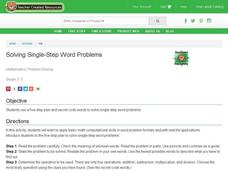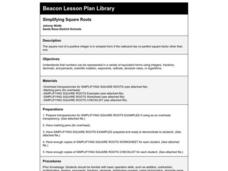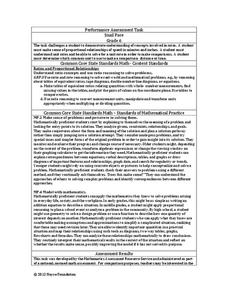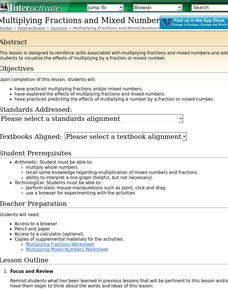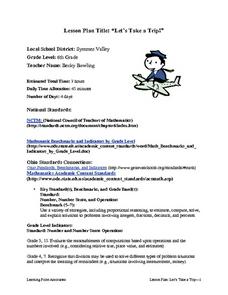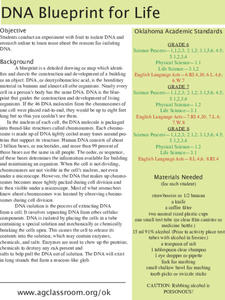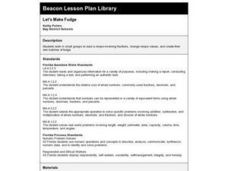Noyce Foundation
Truffles
Knowing how to scale a recipe is an important skill. Young mathematicians determine the amount of ingredients they need to make a certain number of truffles when given a recipe. They determine a relationship between ingredients given a...
Inside Mathematics
Number Towers
Number towers use addition or multiplication to ensure each level is equal. While this is common in factoring, it is often not used with algebraic equations. Solving these six questions relies on problem solving skills and being able to...
Inside Mathematics
Squares and Circles
It's all about lines when going around. Pupils graph the relationship between the length of a side of a square and its perimeter. Class members explain the origin in context of the side length and perimeter. They compare the graph to the...
Curated OER
Solving Single-Step Word Problems
Math wizards learn the five-step plan to solve math word problems. They investigate the five-step process for solving word problems, and examine the use of code words for each of the operations and solve a problem using the strategies.
Curated OER
How Simple Is Your Rational Expression?
Investigate simplifying rational expressions. Learners define rational expressions, review how numerators and denominators are polynomials and complete several problems using a checklist to ensure they don't skip any steps. Work can be...
Curated OER
To Quote or Not to Quote
Introduce your middle and high schoolers to the correct use of quotation marks. They identify examples of correct and incorrect quotations in magazines and edit a paragraph in groups. Use this lesson as a way to reinforce proofreading...
Curated OER
Simplifying Square Roots
Discuss the definition for a simplified form for a square root. Middle schoolers analyze different forms of a square root, the Product Property of Square Roots, and complete a worksheet.
Curated OER
This Land Is Our Land
Young scholars research federal land holdings. They explore how those lands are used. They map these lands and design their own legends. They discuss whether or not the land is being used accordingly.
Curated OER
Nutrition: How Much Fat Am I Eating?
How much fat is in this? Scholars first read some background information on the caloric content of fats versus carbohydrates, and then use that knowledge to analyze foods they regularly eat. They will look at 5 package labels for the...
Curated OER
Measuring the Number Of Calories In Sunlight
High schoolers., in groups, define calorie and compare the absorption of solar energy by three different collectors. They define solar constant and offer several explanations for discrepancies between the data collected and the solar...
Curated OER
Horatio's Ratios
View a PBS video entitled Horatio's Drive and explore Horatio's Ratios. Collaborative learners form groups to use Mapquest to determine distances covered. They generate the mathematical averages, ratios, and rates in order to calculate...
Curated OER
Graphs: All About Our Class
Students respond to survey questions, discuss results, brainstorm ways to represent survey information, and create table of class results. They find mean, range, and percentages, and create graph to display results.
Curated OER
The Flow of Women's Work: How Cultures are Alike and Different?
Students examine gender roles in various cultures. In this flow of women's work lesson, students compare water related work in rural Africa to that in their own households.
Noyce Foundation
Snail Pace
Slow and steady wins the race? In the assessment task, scholars calculate the rates at which different snails travel in order to find the fastest snail. Hopefully, your class will move much more quickly in finishing the task!
Curated OER
Multiplying Decimals and Mixed Numbers
Students practice multiplying decimals and/or mixed numbers, explore the effects of multiplying decimals and mixed numbers, and practice predicting the effects of multiplying a number by a decimal or mixed number.
Curated OER
Time Management
Students plot activities for a 24 hour day. They record their information on a spread sheet program. Students list categories they use and write equations for cells that add cells of each category together. Students create a pie chart of...
Curated OER
Earth's Atmosphere
In this Earth's atmosphere worksheet, learners match 8 terms about the layers of the atmosphere and the components of the atmosphere with their definitions. They complete 5 sentences with the proper terms about the air of the atmosphere...
Curated OER
Applying Proportionality in Scale Drawings
Sixth graders examine a blue print and discuss the reasoning behind using blue prints. In this proportionality activity, students collaborate with their teammates to create a scale drawing. Once that is complete, 6th graders write a...
Curated OER
Hamburger Lesson
Students examine fractions in this instructional activity. They practice with how to reduce and perform operations on fractions.
Curated OER
Let's Take a Trip!
Sixth graders plan a trip for a family of four choosing their travel plan by studying maps to decide upon a route and visiting Websites to get airline and travel schedules. They use ratios and proportions as well as converting fractions...
Curated OER
Word Clue and All About Me Problem Solving
Fifth graders practice solving word problems using highlighted strategies. In this word problem lesson, 5th graders brainstorm and use words as clues that indicate the math operations that will be used to solve problems. They use the...
Curated OER
DNA Blueprint for Life
Did you know that meat tenderizers contain DNA cutting enzimes? Did you know that you can isolate your own DNA? Or the DNA of fruit? Explore with your learners the DNA world with a series of experiments using readily available materials...
Math Mammoth
Ratios and Proportions
For this ratios and proportions instructional activity, learners complete several activities that advance their understanding of proportions and ratios. Students solve six equations and five word problems.
Curated OER
Let's Make Fudge
Students make fudge after reading fractional values in recipes and finding equivalent fractions to those presented in the recipes. They study measurement abbreviations.





